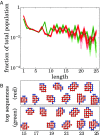Foldamer hypothesis for the growth and sequence differentiation of prebiotic polymers
- PMID: 28831002
- PMCID: PMC5594640
- DOI: 10.1073/pnas.1620179114
Foldamer hypothesis for the growth and sequence differentiation of prebiotic polymers
Abstract
It is not known how life originated. It is thought that prebiotic processes were able to synthesize short random polymers. However, then, how do short-chain molecules spontaneously grow longer? Also, how would random chains grow more informational and become autocatalytic (i.e., increasing their own concentrations)? We study the folding and binding of random sequences of hydrophobic ([Formula: see text]) and polar ([Formula: see text]) monomers in a computational model. We find that even short hydrophobic polar (HP) chains can collapse into relatively compact structures, exposing hydrophobic surfaces. In this way, they act as primitive versions of today's protein catalysts, elongating other such HP polymers as ribosomes would now do. Such foldamer catalysts are shown to form an autocatalytic set, through which short chains grow into longer chains that have particular sequences. An attractive feature of this model is that it does not overconverge to a single solution; it gives ensembles that could further evolve under selection. This mechanism describes how specific sequences and conformations could contribute to the chemistry-to-biology (CTB) transition.
Keywords: HP model; autocatalytic sets; biopolymers; origin of life.
Conflict of interest statement
The authors declare no conflict of interest.
Figures










Similar articles
-
Prebiotic selection for motifs in a model of template-free elongation of polymers within compartments.PLoS One. 2017 Jul 19;12(7):e0180208. doi: 10.1371/journal.pone.0180208. eCollection 2017. PLoS One. 2017. PMID: 28723913 Free PMC article.
-
Generic folding and transition hierarchies for surface adsorption of hydrophobic-polar lattice model proteins.Phys Rev E Stat Nonlin Soft Matter Phys. 2013 Jan;87(1):012706. doi: 10.1103/PhysRevE.87.012706. Epub 2013 Jan 11. Phys Rev E Stat Nonlin Soft Matter Phys. 2013. PMID: 23410358
-
Autocatalytic replication and homochirality in biopolymers: is homochirality a requirement of life or a result of it?Astrobiology. 2012 Sep;12(9):818-29. doi: 10.1089/ast.2012.0819. Epub 2012 Aug 29. Astrobiology. 2012. PMID: 22931294
-
STEREOSPECIFIC POLYMERIZATION. A REVOLUTION IN POLYMER SYNTHESIS HAS OCCURRED IN THE LAST DECADE.Science. 1964 Aug 14;145(3633):667-73. doi: 10.1126/science.145.3633.667. Science. 1964. PMID: 14163799 Review.
-
Peptide Amyloids in the Origin of Life.J Mol Biol. 2018 Oct 12;430(20):3735-3750. doi: 10.1016/j.jmb.2018.05.046. Epub 2018 Jun 8. J Mol Biol. 2018. PMID: 29890117 Review.
Cited by
-
Origins of Life: The Protein Folding Problem all over again?Proc Natl Acad Sci U S A. 2024 Aug 20;121(34):e2315000121. doi: 10.1073/pnas.2315000121. Epub 2024 Aug 12. Proc Natl Acad Sci U S A. 2024. PMID: 39133848 Free PMC article.
-
The Bootstrap Model of Prebiotic Networks of Proteins and Nucleic Acids.Life (Basel). 2022 May 12;12(5):724. doi: 10.3390/life12050724. Life (Basel). 2022. PMID: 35629391 Free PMC article.
-
Origins of life: first came evolutionary dynamics.QRB Discov. 2023 Mar 22;4:e4. doi: 10.1017/qrd.2023.2. eCollection 2023. QRB Discov. 2023. PMID: 37529034 Free PMC article. Review.
-
WITHDRAWN: Structural Enzymology, Phylogenetics, Differentiation, and Symbolic Reflexivity at the Dawn of Biology.bioRxiv [Preprint]. 2025 Jan 14:2024.12.17.628912. doi: 10.1101/2024.12.17.628912. bioRxiv. 2025. Update in: Genome Biol Evol. 2025 May 30;17(6):evaf095. doi: 10.1093/gbe/evaf095. PMID: 39763899 Free PMC article. Updated. Preprint.
-
Protein ensembles link genotype to phenotype.PLoS Comput Biol. 2019 Jun 20;15(6):e1006648. doi: 10.1371/journal.pcbi.1006648. eCollection 2019 Jun. PLoS Comput Biol. 2019. PMID: 31220071 Free PMC article. Review.
References
-
- Joyce G. Nonenzymatic template-directed synthesis of informational macromolecules. Cold Spring Harb Symp Quant Biol. 1987;52:41–51. - PubMed
-
- Eigen M. Selforganization of matter and the evolution of biological macromolecules. Naturwissenschaften. 1971;58:465–523. - PubMed
-
- Eigen M, Schuster P. A principle of natural self-organization. Naturwissenschaften. 1977;64:541–565. - PubMed
-
- Eigen M, Schuster P. The hypercycle. Naturwissenschaften. 1978;65:7–41. - PubMed
Publication types
MeSH terms
Substances
LinkOut - more resources
Full Text Sources
Other Literature Sources
Research Materials
Miscellaneous

